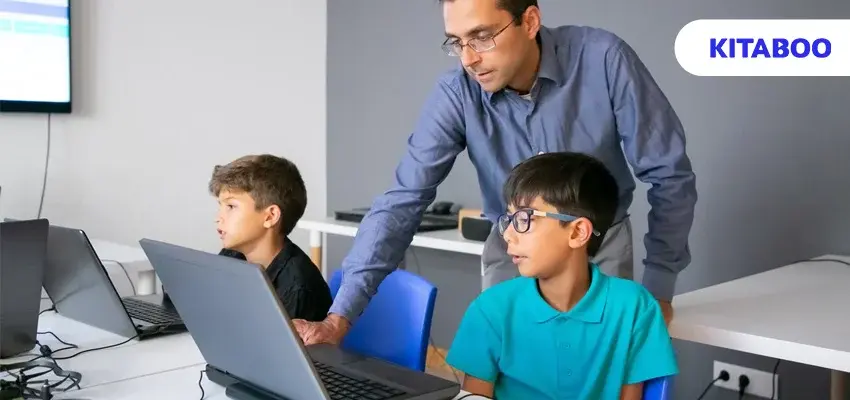
Behind the Scenes: Navigating the Challenges of Technical Support in EdTech
Summarize this blog with your favorite AI:
Technology has made its way into every industry, and the educational publishing industry is no exception. The use of technology in K12 publishing is evident by the rapid rise of digital publishing platforms such as KITABOO.
However, as is the case with technological tools, it takes time for everyone to get used to using them. As a result, technical support teams need to function at the top of their game. If they don’t, certain challenges can arise.
In this blog, we will delve into the behind-the-scenes challenges of technical support in EdTech and discuss solutions for navigating them.
Table of Contents:
I. Challenges of Technical Support in EdTech
- Ticket Management
- Changing Technologies
- Varying User Requirements
- Varying Technical Proficiency of Users
- Maintenance Cost
- Data Security and Privacy
II. Solutions for Technical Support Challenges
- Provide Timely Training
- Use Analytical and Monitoring Tools
- Employ a User-Centric Approach
- Foster Good Interpersonal Skills
- Collect Feedback
- Balance the Workload Across Team Members
- Use Stringent Security Measures
III. The End Note
Challenges of Technical Support in EdTech
Technical support teams can come across a number of challenges when providing tech support to K12 publishers, students or teachers. Some of the prominent challenges include:
1. Ticket Management
One of the top challenges faced by technical support teams is ticket management. The highest proportion (more than 50%) of EdTech end users is made up of students and teachers from K12 educational institutions.
Such a huge number of people using technology in education and facing technical issues can result in an influx of tickets. Dealing with and keeping track of such a huge number of tickets can prove to be quite time-consuming and daunting.
2. Changing Technologies
Innovations are happening almost every day, and as a result, technology remains in a constant state of evolution. Staying up-to-date with the upgrades in technology, resulting in new software and devices, can be very demanding and challenging.
3. Varying User Requirements
Every user has a different set of requirements. Publishers might need more support for content creation while educators may need support to view the content correctly. These varying requirements can be difficult to balance.
4. Varying Technical Proficiency of Users
Although we live in a digital age, not everybody is comfortable with technology. While the younger generation might be more proficient, requiring little guidance, teachers can struggle with using technology and thus require a greater level of technical assistance.
Navigating and accommodating the different levels of technical proficiency can be a challenging balancing act for the technical support team.
5. Maintenance Cost
In today’s evolving digital age, newer versions of cloud software, servers, devices, and more keep coming up. Technological updates in the EdTech market significantly increase the cost of maintenance of the technological tools used by technical support teams.
6. Data Security and Privacy
One of the most significant challenges faced by technical support teams is maintaining data security and privacy. Viruses, phishing, malware attacks, and more can severely compromise the security and privacy of the data provided by K12 students and teachers.
Solutions for Technical Support Challenges
The challenges faced by technical support teams are very much solvable. The solutions for tackling the same are as follows:
1. Provide Timely Training
Holding regular interactive training sessions about the new technological developments in the EdTech industry is essential.
Training sessions familiarize technical support teams with the latest software and devices. When technical support teams are better informed, they are able to better understand their end users and solve tricky technical issues quickly.
2. Use Analytical and Monitoring Tools
Integrating analytical and monitoring tools with existing tech support systems is key to keeping track of the number of complaint tickets generated. In addition to the number, monitoring tools help technical support teams keep track of the status of these tickets.
Besides monitoring tools, analytical tools help support teams analyze and shortlist the major technical issues faced by users. This information helps support teams in developing more efficient strategies for resolving technical issues.
3. Employ a User-Centric Approach
A user-centric approach prioritizes the needs of end-users.
Technical support teams should clearly understand the problems being faced by users and work to resolve them as quickly as possible. Employing a user-centered approach positively impacts the user experience.
4. Foster Good Interpersonal Skills
Technical support team members who can communicate effectively and empathize with users leave a much better impression on users, thereby increasing their retention.
Thus, fostering and promoting the development of good interpersonal skills in technical support teams is very important.
5. Collect Feedback
Seeking feedback from users upon resolution of technical problems is necessary. Feedback enables technical support teams to understand how users view their performance and where they need to improve.
Feedback allows for overall improvement in the performance of technical support teams and enables them to meet user’s expectations.
6. Balance the Workload Across Team Members
An uneven workload distribution among technical support team members increases the odds of burnout and untimely resolution of tickets. To avoid this, balancing the workload evenly among technical support team members is imperative.
A properly balanced workload allows for the timely resolution of technical issues, enabling publishers, students and teachers to continue their coursework without delay.
7. Use Stringent Security Measures
Providing secure technical support in EdTech is key to preventing data from falling into the wrong hands.
Some stringent security measures include using the latest version of antivirus protection software, encrypting user data, putting up a firewall, running regular security checks, and more. Adherence to strict data protection protocols enables support teams to maintain the confidentiality of user data.
The End Note
Providing good technical support and maintenance services can be challenging. However, it is not something that cannot be solved. Thus, holding timely training sessions, fostering good interpersonal skills, employing a user-centric approach, strong security measures, and monitoring and analytical tools are key.
If you are facing any technical support challenges in EdTech and need help with implementing solutions for tackling the same, do connect with KITABOO.
As a leading training platform, KITABOO offers engaging and interactive training content to meet the training needs of your tech support team. In addition, KITABOO also provides monitoring and analytical tools to help your technical support team track, analyze, and manage tickets effectively.
To know more, get in touch with contact@kitaboo.com.
Discover how a mobile-first training platform can help your organization.
KITABOO is a cloud-based platform to create, deliver & track mobile-first interactive training content.

![Top 5 Free Publishing Sites for Independent Publishing [2026]](https://kitaboo.com/wp-content/uploads/2025/09/Top-5-Free-Publishing-Sites-for-Independent-Publishing-2026-420x235.webp)
